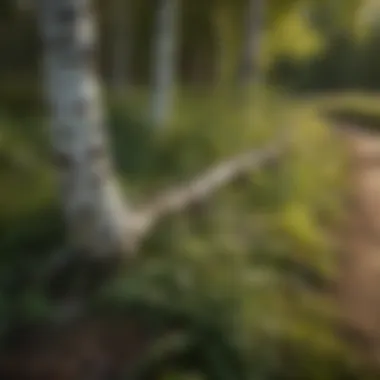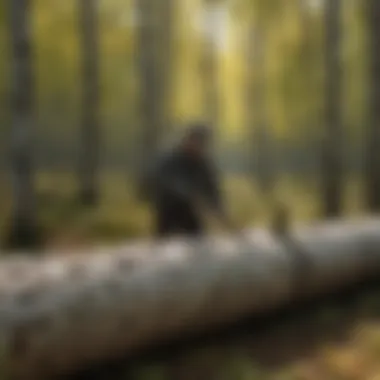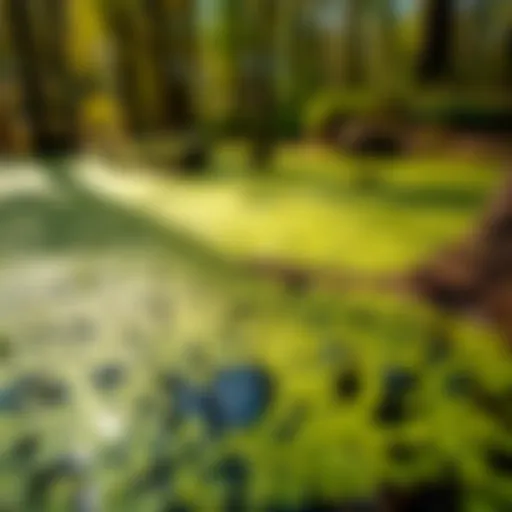Exploring Birch Edging: Techniques and Significance


Intro
Birch edging represents a significant aspect of modern forestry and ecological understanding. It involves the use of birch trees for practical applications such as gardening, landscaping, and woodworking. This article seeks to unravel the complexities surrounding birch edging, offering insights into its techniques and ecological importance.
By examining the relationship between birch trees and their environments, we can better appreciate their role in sustainable practices. We will discuss the importance of biodiversity in forests, the principles of sustainable forestry, and various stewardship techniques.
As we explore these dimensions, we aim to highlight the multifaceted nature of birch edging and its implications for woodland management, giving forestry professionals and academics a deeper understanding of this vital subject.
Understanding Woodland Ecosystems
Understanding the dynamics of woodland ecosystems is crucial when discussing birch edging. Forested areas, primarily composed of diverse tree species like birch, host a wide range of flora and fauna. These ecosystems contribute significantly to the overall health of our planet.
Importance of Biodiversity in Forests
Biodiversity in forests refers to the variety of organisms within a given environment. It supports ecosystem resilience, enhances productivity, and provides essential services. Here are some key points regarding biodiversity in forests:
- Ecosystem stability: Diverse species can withstand changes and stressors more effectively than monocultures.
- Habitat provision: Different species fulfill various roles, creating habitats for numerous organisms.
- Pollination and seed dispersal: Many tree species rely on animals for pollination and the spread of their seeds.
A rich diversity also means that birch trees contribute to the ecosystem beyond their use as edging material. The health of birch trees is reflective of the ecosystem's overall health.
Role of Forests in Climate Regulation
Forests play a pivotal role in climate regulation. They absorb carbon dioxide from the atmosphere, acting as a carbon sink. Birch trees, like others, engage in photosynthesis, which creates oxygen while removing carbon from the air. This process is vital in mitigating climate change effects.
In addition, forests help to:
- Regulate water cycles by managing runoff and maintaining groundwater levels.
- Provide shading, which cools the earth's surface, thereby impacting local and global temperatures.
- Influence weather patterns through evapotranspiration.
Through birch edging, we acknowledge the potential of these trees not just for practical uses but also their indispensable role in our ecosystems.
Sustainable Forestry Practices
Sustainable forestry is essential for providing ongoing ecological, social, and economic benefits. The practices we adopt today will affect future generations.
Principles of Sustainable Forestry
- Ecological balance: Maintaining the health and integrity of forest ecosystems should remain a top priority.
- Socio-economic benefits: Communities should benefit from forest resources while conserving them.
- Long-term perspectives: Planning must take into account the future of both forests and local communities.
These principles help ensure that birch edging, and other forestry practices, do not compromise environmental health.
Case Studies of Successful Implementations
Examining case studies provides tangible evidence of effective sustainable practices. For example, the Forest Stewardship Council’s certification program encourages responsible forest management. In Quebec, Canada, birch trees are harvested selectively, ensuring that the ecosystem remains balanced while still providing valuable resources for the local economy.
Utilizing birch edging not only has aesthetic benefits but can also support sustainable forestry when done correctly.
Woodland Stewardship Techniques
Woodland stewardship ensures that forests are managed wisely. This involves a combination of knowledge, skills, and practices aimed at conserving and improving woodland resources.
Forest Management Plans
A detailed forest management plan outlines the goals and objectives for a specific area. These plans are tailored to address ecological health, biodiversity, and community needs. Key components include:
- Inventory of resources
- Assessment of current ecosystem health
- Strategies for sustainable use
Conservation Strategies
Conservation strategies focus on maintaining healthy ecosystems while promoting the sustainable use of resources. This can include:
- Restoring degraded lands
- Protecting critical habitats
- Implementing controlled harvesting practices
Such techniques not only ensure the sustainability of birch edging but also foster a culture of ecological responsibility within the community.
Quote: "Sustainable management of our forests is not only about protecting them; it is about recognizing their role in our lives and our ecosystem."
Prelims to Birch Edging
Birch edging offers a distinctive approach in both landscaping and woodworking. This section serves to highlight the significance of birch edging, its applications, and the rationale for its growing popularity. With an increasing interest in sustainable practices and ecological awareness, the use of birch for edging aligns well with contemporary environmental goals.
Birch wood, with its light color and fine grain, serves aesthetic and functional purposes in garden and landscape design. Its smooth surface and relative ease of manipulation make it a favorite among woodworking enthusiasts. Because those who pursue woodworking often seek sustainable sources of timber, birch stands out as an ideal option due to its rapid growth and widespread availability.


Furthermore, birch edging affects both the human-created landscape and the surrounding ecology. Using birch in outdoor spaces promotes biodiversity, aiding in creating habitats for various species. It also presents a natural solution for defining garden beds or pathways, contributing to both beauty and functionality in outdoor spaces.
In summary, birch edging encapsulates not only its practical applications but also its ecological significance. As we delve deeper into this topic, we will explore how birch has been used historically and its relevance in modern practices.
Definition and Context
Birch edging refers to the process of utilizing birch wood to create defined borders in landscaping and garden design. This can include pathways, garden beds, or decorative features. The context of birch edging must be understood alongside the characteristics of birch as a material.
Birch is a genus that includes several species, such as Betula papyrifera and Betula pendula. Each species offers distinct qualities suitable for various applications. Traditionally, birch is valued for its workability, allowing artisans and gardeners alike to shape it easily to their needs.
The utility of birch edging extends beyond aesthetics. It can serve practical purposes in erosion control, weed suppression, and moisture retention in soil directly adjacent to bordered areas. Its relevance in landscaping thus lies in its dual function as a connector between design and ecological responsibility.
Historical Uses
Historically, birch wood has been significant in many cultures. Indigenous peoples in North America, for example, used birch bark to create canoes, baskets, and shelter. Its lightweight yet strong properties made it a valuable resource. As a result, the historical use of birch extends beyond practical woodworking, influencing social and cultural aspects of various communities.
In the context of landscaping, the popularity of birch as an edging material has surged in recent decades. Homeowners and landscape designers have revived its use for practical purposes, marrying traditional knowledge with modern design philosophies. Not only has birch maintained its integrity over centuries, but its appeal has expanded to contemporary gardens, emphasizing a more sustainable and organic approach to landscaping.
The Characteristics of Birch Wood
Birch wood is remarkable for its versatility and aesthetic appeal. Understanding its characteristics is essential to appreciate its utility in various applications, particularly in edging. This section examines two vital aspects of birch wood: its physical properties and durability.
Physical Properties
Birch wood is known for its smooth texture and fine grain. The wood displays a light color, often ranging from creamy white to a pale yellowish-brown, which can darken over time with exposure to light. This makes birch appealing for both functional and decorative uses.
The density of birch wood is relatively high, which contributes to its strength and makes it a preferred choice for many woodworkers. The average density ranges around 600 to 750 kg/m³. Additionally, birch has excellent bending strength, making it suitable for edging applications that require both form and function. The wood also has a uniform texture, allowing for a clean finish when sanded.
When it comes to its workability, birch is responsive to a variety of tools and finishes. It can be planed and sanded with ease, allowing craftsmen to achieve a smooth surface. However, care must be taken to avoid tear-out when working with the wood's grain direction.
Durability and Workability
Birch wood is not as durable as some hardwoods like oak or maple, but it offers good resistance to wear and tear when maintained properly. Its susceptibility to moisture means that it is important to use sealed finishes in outdoor applications, especially for birch edging. Proper treatment and regular maintenance can prolong its lifespan dramatically.
In terms of workability, birch wood is quite forgiving. It holds nails and screws well, making it reliable for constructing robust structures. Carving and shaping birch wood can yield excellent results as well due to its fine grain. This flexibility allows artisans to create intricate designs with relative ease.
Despite its advantages, birch wood may require additional care when it comes to finishing, as it can sometimes absorb stain unevenly. One approach to mitigate this issue is to use a pre-stain wood conditioner before applying any finishing products.
"Birch wood, with its unique balance of density and workability, presents a solid choice for numerous applications, particularly in sustainable edging solutions."
In summary, understanding the characteristics of birch wood not only informs its practical uses but also highlights its environmental significance. As we move forward, exploring the applications and techniques that utilize these characteristics will illustrate the broader context of birch edging in today’s landscape management.
Techniques for Birch Edging
Techniques for birch edging are fundamental to the successful application of this natural material in various projects. Understanding these techniques does not only enhance functionality but also fosters sustainability, ensuring that birch wood can be used responsibly and effectively. The focus is on how quality sourcing, proper preparation, and skilled installation can make a significant difference in outcomes, thus emphasizing both the art and science of working with birch.
Sourcing Quality Birch
Choosing the right birch is essential for successful edging. Quality birch typically indicates stronger, healthier wood, which contributes to durability and aesthetics. Professionals should seek birch that has a consistent grain and is free from imperfections such as knots, warping, or discoloration. The best birch tends to come from well-managed forests where sustainable practices are followed.
Consider the following factors:
- Species: Betula pendula (silver birch) and Betula lenta (sweet birch) are popular choices. They each offer different properties but are both valued in edging applications.
- Source: Local suppliers or sustainably managed forests ensure that the birch is harvested with ecological considerations.
- Season: Seasonal timing of collection may affect wood density and moisture content. Harvesting during the right time can enhance the quality of the birch.
Cutting and Preparing Edging Materials
Once birch wood is sourced, proper cutting and preparation are vital steps. These actions are integral not just for aesthetics but also for ensuring longevity of the edging. Techniques in cutting must focus on maintaining the integrity of the wood to prevent splintering or chipping.
Steps to consider include:
- Sawing Technique: Using a circular saw or a handsaw, make precise cuts to avoid unnecessary damage.
- Drying Process: Proper drying methods like air-drying or kiln-drying help stabilize the wood, reducing the likelihood of warping.
- Finishing Touches: Sanding the edges smooth contributes not only to visual appeal but also to safety, especially when used in garden beds where people may come into contact with the wood.
Installation Techniques
Installing birch edging involves various methods tailored to specific applications, ensuring that the edging fits seamlessly into the design while also performing its intended function. Mastery of installation techniques will greatly aid in securing the longevity and functionality of the edging.
Consider the following approaches when installing birch edging:
- Placement: Strategic placement is important. For instance, edging near pathways should be flush with the ground to avoid tripping hazards.
- Securing: The use of stakes or anchoring materials can help secure the birch in place. The method chosen can depend on the specific project requirements and environmental factors.
- Maintenance: Regular inspections of the edging for signs of wear and damage will prolong its life. Simple maintenance such as cleaning and replacing damaged sections can prevent larger issues down the line.
In summary, understanding the techniques for sourcing, preparing, and installing birch wood is essential for anyone interested in leveraging its benefits. These practices empower professionals to create aesthetically pleasing and environmentally responsible projects.


Applications of Birch Edging
Birch edging serves numerous functions across various fields, each showcasing its practicality and significance. Through careful application, birch wood becomes not only a functional element but also an aesthetic asset. Understanding these applications involves recognizing the unique properties of birch and the ways it can enhance environments.
In Landscaping Designs
The use of birch edging in landscaping designs provides both beauty and function. Its naturally light color complements a wide range of plants and garden schemes. When deployed as a border, birch edging aids to define garden spaces clearly, offering a neat and polished look.
The lightweight nature of birch makes it easy to work with during installation. Landscape designers appreciate the versatility of birch, as it can be shaped to fit various contours and design elements. It is common to see birch edging in flower beds, tree rings, and pathways. With natural decay resistance, birch wood can last for years, contributing to the longevity of landscaping projects.
"Effective landscaping not only enhances the aesthetic appeal of a space but also serves functional needs."
In Garden Beds and Walkways
In garden beds and walkways, birch edging provides a practical solution to prevent soil erosion. When soil moves away from the edges of garden plots, it can jeopardize plant health. Birch findings offer a strong physical barrier that holds soil in place, promoting healthier plant growth and root stability.
Moreover, using birch for pathways can enhance navigability within gardens. It prevents weeds from encroaching into designated walking spaces. The light and attractive appearance of birch wood minimizes visual clutter, creating a serene environment. In residential settings, gardens with well-defined pathways improve user experience, allowing individuals to enjoy their surroundings.
In Ecological Restoration Projects
The role of birch edging expands into ecological restoration efforts. Birch trees are crucial for restoring habitats due to their rapid growth and adaptability. They provide shade and shelter for various species, aiding in the recovery of native plants and wildlife. When used for edging in these projects, birch creates boundaries that help guide the restoration process.
Beyond its physical utility, birch edging can serve as a sustainable option in ecological initiatives. Many organizations prioritize materials that promote biodiversity and reduce environmental impact. Incorporating birch in restoration efforts aligns with these principles, promoting sustainability throughout the project.
In summary, the applications of birch edging are multifaceted. From enhancing landscaping aesthetics to assisting in ecological restoration, the versatility of birch wood allows it to play a valuable role across different contexts.
Ecological Significance of Birch
Birch trees, particularly species like Betula papyrifera and Betula pendula, play significant roles in their ecosystems. Their presence influences various ecological processes, making them vital for biodiversity and overall forest health. Understanding this significance provides insights into why birch edging not only serves practical purposes but also promotes ecological balance.
Role in Biodiversity
Birch trees are often pioneers in forest regeneration. They thrive in disturbed soils, which helps stabilize the ground and create suitable conditions for other plant species to grow. This facilitation allows for increased plant diversity in areas where birch trees are present. For instance, birch can attract various insects that depend on its foliage, thus supporting a range of avifauna that feed on these insects. Furthermore, the cavities in mature birch trees often provide nesting sites for birds and habitats for mammals.
- Some of the wildlife supported includes:
- Woodpeckers
- Small mammals like squirrels and chipmunks
- Various insect species, which in turn attract birds
This interconnectedness highlights the role of birch trees as keystone species in forest ecosystems. Their presence enhances habitat complexity, which is crucial for sustaining diverse life forms.
Sustainability and Conservation
Sustainability is central to discussions regarding birch forestry and its applications. The ecological footprint of harvesting birch wood can be minimized through responsible practices that ensure forest health and regeneration. Using birch edging promotes local sourcing of materials, thus reducing transportation emissions and bolstering regional economies.
Conservation efforts can target preserving existing birch populations while promoting reforestation initiatives with birch at their core. This aligns with broader global goals such as combating climate change and preserving biodiversity. Implementing sustainable practices involves:
- Selective harvesting to minimize ecological disruption
- Establishing buffer zones to protect biodiversity hotspots
- Monitoring the health of birch populations to prevent overexploitation
By embracing sustainable harvesting methods and recognizing the ecological value of birch, communities can work towards maintaining a balance between utilizing this resource and conserving it for future generations.
"The careful management of birch forests can lead to enhanced biodiversity and sustainability, benefits that resonate across both ecological and social systems."
Challenges in Birch Edging
The discussion surrounding birch edging cannot be complete without understanding the challenges associated with it. While birch trees offer numerous benefits for edging applications in landscaping, woodworking, and ecological restoration, several obstacles must be addressed to maximize their utility. These challenges include pest and disease pressures, as well as the sustainability of harvesting practices.
Pests and Diseases
Birch trees are vulnerable to a range of pests and diseases that can impact their health and longevity. Pests such as the bronze birch borer pose a significant threat. This insect bores into the wood, causing damage that can lead to tree decline or death. Symptoms often emerge as discolored leaves or premature leaf drop. To manage such threats, it is crucial to monitor birch trees regularly for signs of infestation. Use of integrated pest management strategies can be effective. This could involve the following actions:
- Regular inspections of birch trees to detect early signs of infestation.
- Promoting natural predators of pests, such as specific bird species, that can help control pest populations.
- Responsible application of pesticides when necessary, focusing on targeted interventions to minimize harm to beneficial insects and overall ecosystem health.
Overall, understanding the dynamics of pests and diseases is essential for maintaining the health of birch trees used in edging.
Sustainable Harvesting Practices
Sustainability in harvesting birch for edging applications is another critical challenge. Overharvesting can lead to ecological imbalances and depletion of birch resources. To mitigate these risks, adopting sustainable harvesting practices is imperative. This includes:
- Selective harvesting, which focuses on removing only certain trees while allowing others to flourish. This practice helps maintain a healthy ecosystem and encourages regeneration.
- Implementing replanting protocols after harvesting is crucial. Ensuring that new birch trees are planted helps sustain the population and supports local biodiversity.
- Monitoring growth rates and the overall condition of birch populations to inform future harvesting decisions. This data-driven approach will ensure that harvesting remains sustainable over the long term.
As the interest in birch edging applications grows, it is essential to navigate these challenges thoughtfully. Understanding pest management and sustainable practices leads to effective resource utilization and supports ecological integrity. The future of birch edging depends on striking the right balance between use and preservation.


Future Perspectives on Birch Edging
The future of birch edging holds considerable promise. As societies continue to value sustainability and environmental consciousness, birch edging presents itself as a viable option for diverse applications. This section discusses the potential advancements in both woodworking and ecological research.
Innovation in Woodworking
Innovations in woodworking techniques are crucial for maximizing the utility of birch wood. Recent advancements focus on improving the durability and aesthetic qualities of birch edging. Techniques such as laminated birch construction enhance both strength and visual appeal, allowing for more versatile applications.
Craftsmen are also experimenting with new finishes that protect birch from moisture and pests while highlighting its natural beauty. Technologies like CNC routers enable precise cuts, ensuring every piece fits perfectly in landscaping or furniture designs. This precision reduces waste, making birch edging an environmentally friendly choice.
"As aesthetic standards rise, innovation in materials like birch will be critical in meeting these demands."
Besides this, eco-friendly adhesives and stains are gaining popularity. These materials contribute to a more sustainable approach within the woodworking industry while preserving the integrity of birch wood.
Advancements in Ecological Research
Ecological research continues to uncover the significance of birch in various environments. Birch trees play a crucial role in soil health. Studies show that their root systems help stabilize soil, reducing erosion in vulnerable areas. This characteristic is valuable during ecological restoration projects, making birch a preferred species.
Research efforts are also focusing on optimizing birch’s role in carbon sequestration. As awareness of climate change grows, understanding how birch contributes to carbon absorption can guide forestry practices. Implementing sustainable harvesting methods while monitoring birch's ecological impact will be essential for future planning.
Involving communities in research processes can bridge the gap between scientific findings and practical applications, leveraging local knowledge in birch management. Partnering with academic institutions to study the long-term effects of birch edging can yield insight for sustainable practices.
Continuous innovation and deepening ecological research will elevate birch edging as a preferred material in both construction and environmental restoration.
Case Studies of Successful Birch Edging Projects
The exploration of successful projects involving birch edging reveals practical implications and benefits of using this material. These case studies serve as tangible examples that illustrate how birch wood can enhance both aesthetic and ecological aspects of various environments. The insights drawn from these projects can inform future applications and encourage sustainable practices.
Residential Landscapes
In residential settings, birch edging has proven to be versatile and appealing. Many homeowners opt for birch to define garden beds and pathways. The natural look of birch fits well with various garden designs, adding a rustic charm. A notable project featured the use of birch log edging to create structured raised beds. This not only provided an attractive border but also facilitated easier maintenance of the garden.
Key benefits observed in residential landscapes include:
- Enhanced aesthetic appeal: Birch edging complements natural surroundings.
- Durability: Birch can withstand variations in weather conditions.
- Soil retention: It helps maintain soil structure, particularly in raised bed applications.
These qualities contribute to more sustainable gardening practices and encourage homeowners to consider retiring other materials for birch options.
Public Parks
Public parks often utilize birch edging for pathways and recreational areas. A case study in a local park demonstrated how birch was used to outline walking trails. This application highlighted not only functionality but also the connection between users and nature. The light color of birch contrasts well with greenery, making paths more visible while seamlessly integrating into the park's overall landscape.
Some advantages of birch edging in public parks are:
- Promotion of biodiversity: Edging encourages the inclusion of diverse plant species.
- Public awareness: Using birch draws attention to native resources and sustainability.
- Cost-effectiveness: Birch sourcing can be economical when managed properly.
Such benefits underscore the potential for birch edging to enhance community spaces while supporting ecological principles.
Restoration Areas
In areas of ecological restoration, birch edging has significant roles. One reported project involved the use of birch in wetlands restoration. By incorporating birch logs along the water’s edge, the project aimed to stabilize soil and promote growth of native aquatic plants. This application reveals how birch not only serves functional purposes but also assists in wildlife habitats.
Relevant considerations in restoration areas include:
- Erosion control: Birch aids in preventing soil erosion in vulnerable regions.
- Habitat creation: Provides shelter for various species in restoration settings.
- Ecological balance: Supports the local ecosystem by offering resources.
These successful case studies illustrate that birch edging is not solely an aesthetic choice but a strategic element in both landscape design and ecological stewardship. Integrating this wood into various projects, when implemented thoughtfully, can yield lasting benefits for both the environment and community.
Closure: The Importance of Birch Edging
Birch edging plays a vital role in various aspects of environmental management, landscaping, and woodworking. This article captures its multifaceted applications and underscores its relevance in the current ecological landscape. By examining birch edging thoroughly, we gain insights into its sustainable practices, unique characteristics, and potential benefits. The understanding of birch not only enhances design aesthetics but also contributes positively to ecological dynamics and biodiversity.
Birch wood is renowned for its strength and beauty. It can be effectively used in residential and public landscapes, providing structural integrity while being visually appealing. Moreover, birch edging promotes ecological stewardship. This is achieved by enabling sustainable practices and emphasizing responsible sourcing. Engaging with birch edging leads to a marked improvement in soil health and microhabitat creation, thus benefiting local fauna and flora.
"Sustainable practices not only preserve the environment but also enhance its functionality and aesthetic value."
Overall, birch edging emerges as a critical component in the blend of artistry and ecology in landscaping.
Recap of Key Points
- Versatility: Birch edging can be applied in various settings, such as gardens, parks, and restoration projects.
- Sustainability: The use of birch involves sustainable sourcing and harvesting, aiding in ecosystem management.
- Aesthetic and Functional Value: Birch offers both beauty and utility, enhancing the visual appeal of landscapes while serving practical purposes.
- Ecological Contributions: Promotes biodiversity and improves soil health, making it an essential part of ecological restoration.
Encouragement for Adoption in Practices
As industries and individuals continue to evolve in their approach to environmental interactions, birch edging deserves attention. Integration of birch into various practices can foster a more sustainable future. By adopting birch edging, professionals in landscaping and forestry can actively participate in conservation efforts.
Additionally, stakeholders should consider educational initiatives to raise awareness about the benefits of birch edging. This can inspire both amateur gardeners and seasoned professionals to embrace birch as a practical, sustainable option.
To conclude, highlighting the importance of birch edging within environmental practices not only supports sustainable development but also enriches the living landscapes we engage with.







